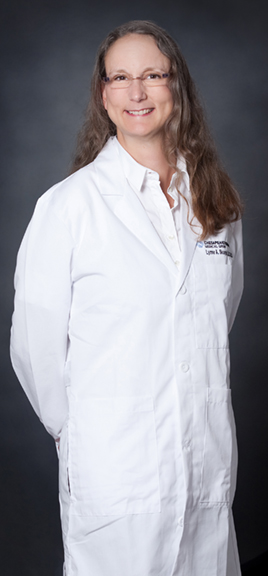Head, Division of Thoracic Surgery, Chesapeake Regional Medical Center
Co-director, Chesapeake Regional Medical Center Lung Health Program
~ Robotic Thoracic Surgery
 Dr. Lynne Skaryak joined the team at Chesapeake Regional Medical Center in December 2014. She specializes in malignancies of the lung, esophagus and chest wall. Dr. Skaryak graduated from Duke University School of Medicine, and completed both her general surgery and cardiothoracic residencies at Duke University Medical Center – the first female to complete Duke’s cardiothoracic program. “We were just starting to do video-assisted minimally invasive thoracic surgery,” she remembers, of the procedure pioneered by Dr. Robert McKenna of Cedars-Sinai. When she was an attending surgeon at Swedish Medical Center in Seattle, Dr. Skaryak learned the technique from Dr. Ralph Aye, who trained with Dr. McKenna at Cedars.
Dr. Lynne Skaryak joined the team at Chesapeake Regional Medical Center in December 2014. She specializes in malignancies of the lung, esophagus and chest wall. Dr. Skaryak graduated from Duke University School of Medicine, and completed both her general surgery and cardiothoracic residencies at Duke University Medical Center – the first female to complete Duke’s cardiothoracic program. “We were just starting to do video-assisted minimally invasive thoracic surgery,” she remembers, of the procedure pioneered by Dr. Robert McKenna of Cedars-Sinai. When she was an attending surgeon at Swedish Medical Center in Seattle, Dr. Skaryak learned the technique from Dr. Ralph Aye, who trained with Dr. McKenna at Cedars.
She continued to perform these procedures for several years, while becoming increasingly interested in the potential of robotic surgery. When the daVinci® Xi™ system debuted, she says, she became more enthusiastic. “The Xi is really designed for thoracic surgery,” she says. “Its platform is much more suitable, with a new stapler that provides fully wristed articulation, allowing surgeons to control stapling directly from the console. Even the way we dock the robot is simpler.” She traveled to New York University for extensive training courses on the da Vinci Xi with Dr. Michael Zervos, starting with smaller cases like wedge resections, before undertaking the more advanced lobectomies and thymectomies that she has introduced to Hampton Roads.
Her first major case at Chesapeake Regional Medical Center was a lobectomy on July 6, 2015, with her NYU trainer as proctor. Six weeks later, she performed a thymectomy, again with Dr. Zervos as proctor. Both procedures were successful, and both of her patients have continued to do well.
Patients like the robotic procedures, Dr. Skaryak says, “because we’re offering a less painful surgery, and a shorter recovery period.” And from the oncologic standpoint, she notes, “The visualization is unparalleled. It’s 3-D versus 2-D, so we’re able to obtain more lymph nodes with the Xi, and some physicians believe that helps prevent recurrence.” She believes that’s true, but adds, “I think the biggest advantage is that it helps us accurately stage the patient.” She explains: “If surgeons don’t take enough lymph nodes, they can miss metastasis, and possibly give patients a prognosis that might significantly improve with the addition of chemotherapy or radiation post-op.”
The Xi has proved significant for Dr. Skaryak’s thymectomy patients as well. Tumors in the thymus gland are usually associated with myasthenia gravis, a chronic autoimmune neuromuscular disease that can be devastating. “We know that if you have myasthenia, you have a chance of having a thymoma,” Dr. Skaryak says. “But if we can remove the thymus in the first year of diagnosis of myasthenia, it reduces the amount of medication the patient needs, and sometimes we can get patients off medication altogether by removing the thymus early.” To be effective, surgeons must remove the entire thymus, but historically had to perform a sternotomy, and even then, experienced problems with visibility. “Now, using the robot, with just three tiny incisions, we can see and remove the entire thymus,” she says. Her first thymectomy patient went home on day one, and four days later, was managing her pain effectively with Motrin.
Dr. Skaryak notes that only about 25 percent of lobectomies in Hampton Roads have been done with any minimally invasive technique. “That number is low given the percentages across the country,” she says. “The lowest in America is usually around 30 percent, even up to 50 percent.”
With her arrival in Hampton Roads, the odds for all of Dr. Lynne Skaryak’s patients just got better.

